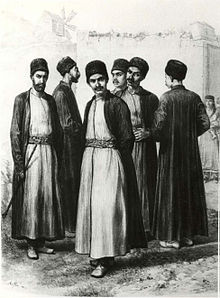Qarayim
 | |
| Herêmên ku lê şêniyên sereke ne | |
|---|---|
| 500[1] | |
| 450 (290 li krîmê)[2][3][4] | |
| 350[5] | |
| 231[6] | |
| 215[4] | |
| 192[7] | |
| Ziman | |
| zimanê qarayim, rûsî، ukrayni، tirkî | |
| Baweriya dînî | |
| cihûtî, xristiyanî[8][9] | |
Qarayim komekî ya tirkî in ku bi piranî li Ewropaya Navîn û Rojhilat dijîn. Ew gel bi piranî baweriya dînê Cihûtî ye.
Dîrok
[biguhêre | çavkaniyê biguhêre]Ew bi sedsalan li Kirimê dijîn. Ew ji Tirkên Asyaya Navîn ên ku êrîşî Kirimê kirin û biryar dan ku bibin Cihûtiyê û bi cih bibin.[10][11] Gel bi xwe jî ev yek piştrast kir û got ku xwîna wan a Semîtîk nîne û bi tevahî tirk in, lê ji aliyê olî ve cihû ne.[12]
Di sedsala 19. de ji bo ku nebin hedefa naziyan û rûsan, tirkbûna xwe wek hincet nîşan dan. Vê yekê ew ji Holokostê bêpar hiştin, berevajî Cihûyên tirk ên din, wek Qirimçaq, ku li ber tunekirinê bûn. Qarayimên ji Naziyan kurmê vedişêrin û alîkariya wan dikirin, ew sax bûn, lê dîsa jî neçar bûn ku tiştên pir nemirovane bikin. Ew her tim li kêleka Qirimçaqên, komeke din a etnîkî ya Cihûyên Tirk, dijîn.[13][14]
Çavkanî
[biguhêre | çavkaniyê biguhêre]- ^ The Karaites of Galicia : an ethnoreligious minority among the Ashkenazim, the Turks, and the Slavs, 1772-1945. Brill. 2008. ISBN 978-90-47-44288-2.
- ^ 1,196 Karaites in the Ukraine as a whole (including the Crimea) Распределение населения по национальности и родному языку УКРАИНА Distribution of the population by nationality and mother tongue, Ukraine (Russian language version)
- ^ Population in Autonomous Republic of the Crimea = 671, population in Sevastopol city council area = 44. 671+44 = 715. Распределение населения по национальности и родному языку, Автономная Республика Крым (Distribution of the population by nationality and mother tongue, Autonomous Republic of the Crimea )
Распределение населения по национальности и родному языку, Г.Севастополь (горсовет) (Distribution of the population by nationality and mother tongue, Sevastopol city council) - ^ a b "Национальный состав населения Российской Федерации согласно переписи населения 2021 года". Roja gihiştinê 3 kanûna paşîn 2023.
- ^ Ludność. Stan i struktura demograficzno-społeczna.Narodowy Spis Powszechny Ludności i Mieszkań 2011.
- ^ "Global population data, UN".
- ^ https://osp.stat.gov.lt/en/gyventoju-ir-bustu-surasymai1
- ^ Album "Archive of the Dmitri Penbeck’s family" – compiled by V. Penbek — Simferopol-Slippery Rock, 2004. — C. 24
- ^ Кропотов В. С. Военные традиции крымских караимов — Симферополь, 2004. — C. 75
- ^ "Karaites of Crimea: History and Present-Day Situation in Community". video-en.jewseurasia.org. Roja gihiştinê 5 sibat 2023.
- ^ "The second avenue of approach, which, due to the specificity of the activities of Karaite community, is mostly supported by researchers in Eastern Europe, is related with the transformation of Karaite identity. Researchers tend to accept the theory of Karaite Khazarian origins, and apply it in their studies. Because of its limitations – the critical application of this approach to the Karaites history before the 20th c. is logically almost impossible – the Karaite studies are not sufficiently developed in this region. And in the last decades this approach attracts even less adherents – with an exception of more of descriptive nature, journalistic initiatives, which are supported by Lithuanian Karaite community. While the Khazarian approach is rather critically assessed by the academic community". Dovile Troskovaite. "Identity in Transition: The Case of Polish Karaites in the first half of the 20th century". University of Klaipeda (Lithuania), 2013, p. 210
- ^ Blady 2000, pp. 113–130.
- ^ Green passim.
- ^ "Somewhat Jewish, Fully Russian: Crimea Karaites Recall Past Glory". Haaretz (bi îngilîzî). 30 adar 2014. Roja gihiştinê 18 kanûna pêşîn 2019.
| Ev gotara kurt şitlekê ye. Heke tu bixwazî berfireh bikî pê li biguhêre bike. (Çawa?) |
